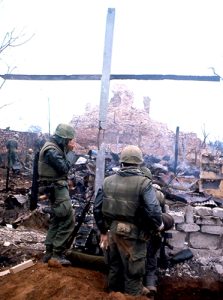Myron Harrington, recipient of the Navy Cross, to tell story of the Battle of Hue
June 6, 2023Retired Col. Myron Harrington, USMC, hasn’t visited the new Vietnam exhibit at the South Carolina Confederate Relic Room and Military Museum yet. But when he does, he’ll see something familiar – the fatigues he wore in battle.
A few yards away, he’ll see something else, also a part of the new exhibit, “A War With No Front Lines: South Carolina and the Vietnam War, 1965-1973.” It’s a life-sized scene reproducing part of the Marines bitter fight to save the city of Hue during the Tet Offensive.
That’s where Harrington – then a captain commanding Company D, First Battalion, Fifth Marines, First Marine Division – earned the Navy Cross for his actions on Feb. 23, 1968.
Col. Harrington will retell the story of that battle in a free lecture at the Relic Room on Friday, June 16. The program is part of the museum’s monthly Lunch and Learn program.
His purpose isn’t so much to tell of his own heroism, or that of his men in Company D. He aims to address the larger implications of the battle, and its role in the war and its outcome.
The Tet Offensive was a shocking development in the war – simultaneous attacks by North Vietnamese and Viet Cong troops that more or less struck everywhere at the same time across the multiple Corps areas of South Vietnam. It was a military failure for the Communist forces, largely because the wide popular uprising that Hanoi had expected to spark failed to materialize. But the attacks succeeded in the long run in shaking American confidence back home in the war effort.
Some of the most intense fighting during the offensive happened in the city of Hue.
At the start of the year, Harrington was a supply officer in Da Nang, far from the fighting. But in February, he was leading a company through the most intense combat of the Tet Offensive. His company was among those called in to help South Vietnamese troops retake the Citadel in Hue, the historic Imperial City that contained treasures of incalculable cultural importance.
How had he gotten there? Originally from Decatur, Ga., Harrington decided to attend The Citadel – not the one in Hue, but the military college in Charleston. He was interested in a military career, and as what he terms “a poor student,” he thought he could use the extra structure and discipline. After graduation, he found himself drawn by “the mystique, if you will, of the Marines.”
“That’s the branch I want to be with,” he decided.
He served for a time in Okinawa, and was attached to Force Logistics Command in the Danang area. He was moved from that supply role to leading combat Marines only a few days before Tet got underway. But every Marine is trained to be a rifleman, and “I felt confident in my abilities.” They moved into Hue on Feb. 11.
What was the battle like? “Start with uncertainty, fear, confusion and chaos,” says Harrington.
He’ll tell more details on June 16. But here’s what his Navy Cross citation said about what happened next:
“Continuously moving from one position to another, he pinpointed enemy emplacements and skillfully directed the fire of his men. After silencing four hostile positions, he requested supporting arms fire and skillfully adjusted 60-mm. mortar fire to within twenty-five meters of the forward elements of his company, while simultaneously adjusting artillery fire. Disregarding his own safety, Captain Harrington then fearlessly maneuvered to the point of heaviest contact and, rallying his men, boldly led a determined assault against the enemy soldiers…. Largely due to his resolute determination and intrepid fighting spirit, his men overran the hostile positions and routed the North Vietnamese soldiers, accounting for twenty-five enemy soldiers confirmed killed.”
In other words, the Corps found that the captain was right to feel confident in his abilities.
About the South Carolina Confederate Relic Room and Military Museum
Founded in 1896, the South Carolina Confederate Relic Room and Military Museum is an accredited museum focusing on South Carolina’s distinguished martial tradition through the Revolutionary War, Mexican War, Civil War, Spanish-American War, World Wars I and II, Vietnam, the War on Terror, and other American conflicts. It serves as the state’s military history museum by collecting, preserving, and exhibiting South Carolina’s military heritage from the colonial era to the present, and by providing superior educational experiences and programming. It recently opened a major new exhibit, “A War With No Front Lines: South Carolina and the Vietnam War, 1965-1973.” The museum is located at 301 Gervais St. in Columbia, sharing the Columbia Mills building with the State Museum. For more information, go to https://crr.sc.gov/.













